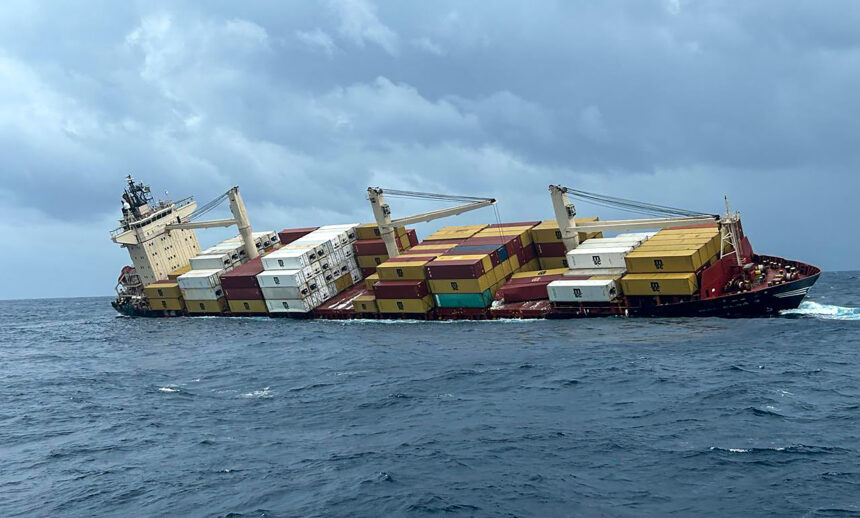Shipwreck & Showdown: MSC Elsa-3 Tests India’s Maritime Law and Coastal Protection
The Mediterranean Shipping Company (MSC) Elsa-3 shipwreck has grown into a test of India’s coastal governance and legal reach. When the Liberian-flagged container vessel sank off Kerala in May 2025, it released oil and hazardous cargo that continue to poison the Arabian Sea and devastate local fisheries. In response, after four months, the Kerala high court has ordered the Mediterranean Shipping Company to provide Rs. 1,227.62 crore as security and kept a sister ship under arrest – a move that shows how a state can wield national admiralty law to defend livelihoods and marine ecosystems against powerful global shipping interests.
High court order, fishermen’s agitation, and CMLRE findings
On September 25, 2025, the Kerala high court delivered a landmark interim order in the long-running legal battle over the Mediterranean Shipping Company (MSC) Elsa-3 shipwreck. Justice M.A. Abdul Hakim directed the Mediterranean Shipping Company (MSC) to deposit Rs. 1,227.62 crore as compensation for the extensive environmental and economic damage caused when the Liberian-flagged container vessel sank off the Kerala coast on 25 May 2025. This figure revises the earlier July directive of Rs. 9,531 crore, but the court retained its order of conditional arrest of MSC’s sister ship, MSC Akiteta II, at Vizhinjam Port until security is furnished.
The order arrived amid angry demonstrations by Kerala’s fishing community, who have faced steep income losses since the disaster. Fisher leaders, carrying oil-stained nets, protested before the state secretariat, demanding an accessible compensation system and a clear timetable for claims. Many families say they have lost Rs. 25,000–Rs. 35,000 per month as fish stocks declined and nets were ruined by the spill.
Meanwhile, scientists from the Centre for Marine Living Resources and Ecology (CMLRE) under the Ministry of Earth Sciences have confirmed severe ecological damage. Their field survey found persistent oil slicks, high levels of polyaromatic hydrocarbons such as naphthalene and anthracene, and toxic metals including nickel, copper and lead. They documented stressed fish larvae, dying benthic species, and even an oil-soiled seabird taking refuge on the wreck
Together, the court’s legal action, the fishermen’s agitation, and the CMLRE’s scientific warnings have turned the Elsa-3 tragedy into a test case for India’s ability to hold global shipping accountable and to protect its fragile marine ecosystems.
Also Read: Trump Slaps 25% Tariffs on Pharmaceuticals, Heavy Trucks & Kitchen Cabinets Starting October 1, 2025
Kerala high court’s admiralty order: Legality and implications
The September ruling builds on the Admiralty (Jurisdiction and Settlement of Maritime Claims) Act, 2017, which empowers designated high courts to entertain claims for maritime damage and to proceed in rem, that is, directly against a vessel. Acting under Sections 4 and 5 of the Act, the Kerala government filed an admiralty suit seeking Rs. 9,531 crore for environmental harm, fishers’ livelihood losses, and clean-up expenses. The high court initially ordered the arrest of the sister ship MSC Akiteta II – present in Vizhinjam Port – on July 7, 2025, finding an “arguable maritime claim.”
MSC challenged both the amount and Kerala’s jurisdiction, arguing that the accident site lay 14.5 nautical miles beyond the state’s maritime boundary. The court, however, ruled that jurisdiction extends as long as the defendant vessel is within the territorial waters of India when arrested. By reducing the security from Rs. 9,531 crore to Rs. 1,227.62 crore, the bench balanced the need to secure compensation with the principle of proportionality.
The order keeps the vessel under arrest until MSC deposits the amount or provides equivalent security, ensuring that India can enforce a final judgment even if the foreign owners later try to remove the ship.
This approach is significant for two reasons. First, it reinforces that environmental harm to India’s Exclusive Economic Zone (EEZ) – even beyond the 12-nautical-mile territorial sea – can be pursued in Indian courts if the offending ship is subsequently within reach.
Second, it demonstrates how admiralty jurisdiction acts as a powerful tool for environmental accountability. By proceeding against the ship itself, rather than relying solely on diplomatic channels or the ship’s flag state (Liberia), Kerala’s suit bypasses many of the enforcement problems that often plague transnational pollution cases.
Critics note, however, that reducing the security amount risks undermining deterrence and may not cover long-term ecological losses. However, the court’s reasoning signals a careful balance between investor concerns and the polluter-pays principle, showing that Indian courts are willing to innovate within existing maritime law to protect coastal communities.
CMLRE report: Scientific proof of ecological damage
The CMLRE’s investigation provides the clearest scientific confirmation of the fishermen’s fears. A dedicated research cruise from 2–12 June 2025 sampled 23 stations between Kochi and Kanyakumari, with intensive monitoring at the wreck site.
Key findings include:
- Oil persistence: An oil slick of nearly two square miles remained visible days after the sinking, despite strong south-westerly currents. Continued leakage from unsealed fuel compartments was evident.
- Chemical contamination: Water and sediment samples showed elevated petroleum hydrocarbons, notably naphthalene, fluorene, anthracene, phenanthrene, fluoranthene, and pyrene. Trace metals such as nickel, copper, lead, and vanadium were also detected.
- Biological stress: Zooplankton carried high levels of hydrocarbons, implying bio-accumulation through the food chain. Fish eggs and larvae collected during the southwest monsoon spawning season showed decay and mortality, threatening future fish stocks. Benthic life collapsed, with only pollution-tolerant worms and bivalves surviving.
- Higher marine life: A Brown Noddy seabird was observed repeatedly preening oil-soiled feathers, a classic sign of contamination.
- Microbial Response: Hydrocarbon-degrading bacteria proliferated, confirming heavy oil presence but also highlighting the limits of natural bioremediation.
The report concludes that the Elsa-3 wreck has caused “significant ecological disruption” and recommends urgent sealing of the wreck’s fuel tanks and long-term monitoring to protect marine ecosystems and fisheries resources.
For Kerala’s fishers, the findings validate months of anecdotal evidence – dead fish, oil-stained nets, and sharp declines in catch. They also strengthen the state’s legal claim that compensation must cover future ecological losses and not merely immediate clean-up costs. Environmental groups like Greenpeace India had warned early that the wreck was a “ticking ecological time bomb,” and the CMLRE’s data now confirm that warning.
The larger lesson is this: even a single deep-sea shipwreck can create a chronic source of hydrocarbon pollution, far harder to contain than surface spills. Without rapid containment, the damage spreads invisibly through the food web, threatening both biodiversity and human health.
Jurisdiction, precedents, and lessons for India
The Elsa-3 case raises an important question: can an Indian state claim damages for pollution occurring beyond its 12-nautical-mile territorial limit? Under the United Nations Convention on the Law of the Sea (UNCLOS), India has rights in its Exclusive Economic Zone (up to 200 nautical miles) to protect marine resources. The Admiralty Act of 2017 empowers certain high courts, including Kerala’s, to arrest foreign ships present in Indian waters for maritime claims – even if the incident occurred on the high seas – so long as the defendant vessel is within reach.
India has precedents. After the MT Enrica Lexie shooting (2012), Kerala asserted jurisdiction when Italian marines killed two Indian fishermen 20 nautical miles offshore. In the Erika oil spill (France, 1999) and the Prestige disaster (Spain, 2002), European courts similarly held shipowners liable despite complex flag-state issues. These experiences show that domestic courts can play a decisive role when international enforcement is weak.
However, the Elsa-3 disaster also exposes gaps. First, delays in wreck-sealing allowed continued leakage, proving that emergency response mechanisms remain inadequate. Second, the reliance on ad-hoc compensation negotiations means fishers often wait months or years for relief, while corporate owners exploit jurisdictional loopholes.
Third, the reduction of the security amount from Rs. 9,531 crore to Rs. 1,227 crore indicates the challenge of fully valuing ecological loss, which often manifests over decades.
Policy lessons are clear:
- Stronger national contingency planning is essential, with rapid-response teams capable of sealing wrecks and containing oil within days.
- India should consider a dedicated Marine Pollution Liability Fund, financed through port fees on foreign shipping, to provide immediate payouts while litigation continues.
- Regional cooperation with Sri Lanka and Maldives is critical, as currents can carry pollutants across boundaries.
Finally, the case affirms that states within India can and must act when their marine resources are threatened, even if the disaster occurs outside their narrow territorial sea. It also demonstrates that science-backed legal action – linking meticulous field data to admiralty jurisdiction – can compel powerful shipping interests to accept responsibility.
The MSC Elsa-3 shipwreck is not just an isolated accident. It is a stress test for India’s coastal governance, for the resilience of marine ecosystems, and for the ability of courts to enforce the polluter-pays principle against global shipping giants. The Kerala high court’s assertive use of admiralty law, the fishermen’s persistent protests, and the CMLRE’s rigorous science together form a template for future action. But the long-term outcome will depend on sustained monitoring, swift compensation, and the political will to strengthen India’s maritime environmental safeguards before the next disaster strikes.
Also Read: Russia’s New Law on Foreign Agent Books Tightens Control on Free Speech








